Mary Kay Carson's Blog, page 7
November 2, 2016
Native Americans Writing Today (And a Nod to the Past, Too)
by Brandon Marie Miller
Activity: Investigate History and Storytelling, Lone Dog's Winter Count, A Nakota Pictograph of 1851-1852.
To celebrate Native American Heritage month I'm sharing the names of just a few of the Native American authors writing for young people today. Add their books to your to-read stack and please use the link below to check out more authors and books.
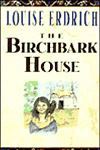 Louise Erdrich (Ojibway). Her award-winning novels for adults and young people include the middle grade trilogy The Birchbark House (winner of the National Book Award), The Game of Silence and The Porcupine Year.
Louise Erdrich (Ojibway). Her award-winning novels for adults and young people include the middle grade trilogy The Birchbark House (winner of the National Book Award), The Game of Silence and The Porcupine Year.
Cynthia Leitich Smith (Muscogee). Her books include, Jingle Dancer a story for younger readers, the novel Rain is Not My Indian Name, and the YA Ferrel and Tantalize series that combine elements of sci-fi, fantasy, mystery and suspense.
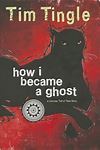 Tim Tingle (Choctaw) has won several American Indian Youth Literature Awards for historical novels House of Purple Cedar and How I became A Ghost, a story about the Choctaw Trail of Tears. His book No Name is set in the present-day Choctaw Nation of Oklahoma.
Tim Tingle (Choctaw) has won several American Indian Youth Literature Awards for historical novels House of Purple Cedar and How I became A Ghost, a story about the Choctaw Trail of Tears. His book No Name is set in the present-day Choctaw Nation of Oklahoma.
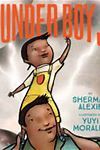 Sherman Alexie's The Absolutely True Diary of a Part-Time Indian won the National Book Award for Young People's Literature. His numerous books include The Lone Ranger and Tonto Fistfight in Heaven, Reservation Blues and Thunder Boy Jr.-- his first picture book.
Sherman Alexie's The Absolutely True Diary of a Part-Time Indian won the National Book Award for Young People's Literature. His numerous books include The Lone Ranger and Tonto Fistfight in Heaven, Reservation Blues and Thunder Boy Jr.-- his first picture book.
S. D. Nelson (Lakota) is a writer and illustrator. His books include Black Elk's Vision, A Lakota Story, Buffalo Bird Girl, A Hidatsa Story, and Greet the Dawn, The Lakota Way.
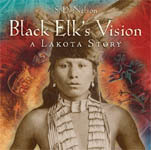
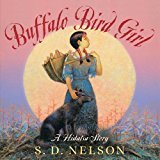
Among Joseph Bruchac (Abenaki) many books is Crazy Horse's Vision (illustrated by S.D. Nelson), Children of the Longhouse, and Keepers of the Earth, Native American Stories and Environmental Activities for Kids.


To discover many more books by and about Native People check out:
https://americanindiansinchildrensliterature.blogspot.com/p/best-books.html
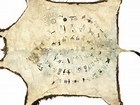 Activity:
Activity:
Take a close look at Lone Dog's Winter Count-- the Nakota Peoples' pictograph calendar.What stories and history are kept alive on this buffalo hide, covering the winter of 1851-1852? From the National Museum of the American Indian.
http://nmai.si.edu/sites/1/files/pdf/education/poster_lone_dog_final.pdf
Activity: Investigate History and Storytelling, Lone Dog's Winter Count, A Nakota Pictograph of 1851-1852.
To celebrate Native American Heritage month I'm sharing the names of just a few of the Native American authors writing for young people today. Add their books to your to-read stack and please use the link below to check out more authors and books.
 Louise Erdrich (Ojibway). Her award-winning novels for adults and young people include the middle grade trilogy The Birchbark House (winner of the National Book Award), The Game of Silence and The Porcupine Year.
Louise Erdrich (Ojibway). Her award-winning novels for adults and young people include the middle grade trilogy The Birchbark House (winner of the National Book Award), The Game of Silence and The Porcupine Year. Cynthia Leitich Smith (Muscogee). Her books include, Jingle Dancer a story for younger readers, the novel Rain is Not My Indian Name, and the YA Ferrel and Tantalize series that combine elements of sci-fi, fantasy, mystery and suspense.
 Tim Tingle (Choctaw) has won several American Indian Youth Literature Awards for historical novels House of Purple Cedar and How I became A Ghost, a story about the Choctaw Trail of Tears. His book No Name is set in the present-day Choctaw Nation of Oklahoma.
Tim Tingle (Choctaw) has won several American Indian Youth Literature Awards for historical novels House of Purple Cedar and How I became A Ghost, a story about the Choctaw Trail of Tears. His book No Name is set in the present-day Choctaw Nation of Oklahoma. Sherman Alexie's The Absolutely True Diary of a Part-Time Indian won the National Book Award for Young People's Literature. His numerous books include The Lone Ranger and Tonto Fistfight in Heaven, Reservation Blues and Thunder Boy Jr.-- his first picture book.
Sherman Alexie's The Absolutely True Diary of a Part-Time Indian won the National Book Award for Young People's Literature. His numerous books include The Lone Ranger and Tonto Fistfight in Heaven, Reservation Blues and Thunder Boy Jr.-- his first picture book.S. D. Nelson (Lakota) is a writer and illustrator. His books include Black Elk's Vision, A Lakota Story, Buffalo Bird Girl, A Hidatsa Story, and Greet the Dawn, The Lakota Way.


Among Joseph Bruchac (Abenaki) many books is Crazy Horse's Vision (illustrated by S.D. Nelson), Children of the Longhouse, and Keepers of the Earth, Native American Stories and Environmental Activities for Kids.


To discover many more books by and about Native People check out:
https://americanindiansinchildrensliterature.blogspot.com/p/best-books.html
 Activity:
Activity: Take a close look at Lone Dog's Winter Count-- the Nakota Peoples' pictograph calendar.What stories and history are kept alive on this buffalo hide, covering the winter of 1851-1852? From the National Museum of the American Indian.
http://nmai.si.edu/sites/1/files/pdf/education/poster_lone_dog_final.pdf
Published on November 02, 2016 08:58
September 30, 2016
The Role of Women Pilots in WWII
[Activity: Experiment to see how stealth planes hide]
By Carmella Van Vleet (Our guest blogger extraordinaire!)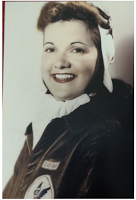 Elaine HarmonLast month, World War II pilot Elaine Harmon was laid to rest at Arlington National Cemetery. This was a special event, one that Elaine’s family worked and fought hard to see happen for many years. Even though many women are already buried in Arlington, up until recently, Elaine and other women like her weren’t allowed there even though they played a crucial role in the second World War.
Elaine HarmonLast month, World War II pilot Elaine Harmon was laid to rest at Arlington National Cemetery. This was a special event, one that Elaine’s family worked and fought hard to see happen for many years. Even though many women are already buried in Arlington, up until recently, Elaine and other women like her weren’t allowed there even though they played a crucial role in the second World War.
Elaine Harmon was a WASP, or a member of the Women Air Force Service Pilots. The WASPs were female pilots who flew planes in a non-combat capacity during WWII. Not only did they fly supplies and deliver aircrafts to military bases, but they helped train other pilots and tested aircraft. Their efforts meant that male pilots were freed up to fly combat missions.
These women pilots were highly trained and the work was often dangerous - the enemy couldn’t tell and didn’t care who was flying an airplane. Thirty-eight of them were killed during the war. And yet, they were considered civilians and therefor didn’t qualify for a military burial in Arlington.
 Click to find out more!The WASPs were largely the result of efforts of two women: Jacqueline “Jackie” Cochran and Nancy Harkness Love. When the war broke out, Cochran, a star pilot with speed and altitude records in America, wrote to Eleanor Roosevelt and suggested female pilots could help in the efforts. Lady Eleanor agreed and so Cochran began training female pilots in Great Britain. She later returned to America to train women. In the meantime, Love (a race and test pilot) formed the Women Auxiliary Ferrying Squadron. The two groups of women joined together in 1943 and became WASP.
Click to find out more!The WASPs were largely the result of efforts of two women: Jacqueline “Jackie” Cochran and Nancy Harkness Love. When the war broke out, Cochran, a star pilot with speed and altitude records in America, wrote to Eleanor Roosevelt and suggested female pilots could help in the efforts. Lady Eleanor agreed and so Cochran began training female pilots in Great Britain. She later returned to America to train women. In the meantime, Love (a race and test pilot) formed the Women Auxiliary Ferrying Squadron. The two groups of women joined together in 1943 and became WASP.
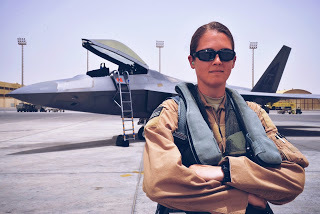 Kristin Wolfe in front of Raptor (credit: Kristin Wolfe)Because of women like Cochran, Love, and Harmon, girls today can grow up dreaming about being a pilot or flying in the military.
Kristin Wolfe in front of Raptor (credit: Kristin Wolfe)Because of women like Cochran, Love, and Harmon, girls today can grow up dreaming about being a pilot or flying in the military.
I wrote about one of these young women in my new book, AVIATION: COOL WOMEN WHO FLY (Nomad Press). Her name is Kristin Wolfe. Kristin is a 27-year-old Air Force pilot who grew up in a military family but didn’t decide she wanted to serve until she was college. After her dad encouraged her to join the AFROTC (Air Force Reserve Officer Training Corp.), Kristin enlisted and began training to become a pilot.
The training to become an Air Force fighter pilot is extremely competitive. There were only 25 students in Kristin’s class. And only a couple of them were women! But Kristin excelled and was given the opportunity to fly the F-22 Raptor, the fastest and one of the most technologically impressive stealth aircrafts in the world.
Activity: Experiment to see how stealth planes hide
(From Aviation: Cool Women Who Fly )
Here’s a simple way to see how much harder it is for radar to find a stealth plane. First, have a friend hold a piece of paper perpendicular in relationship to the floor. Have the friend stand at one send of a dark hall or room and then turn off the lights. Move a flashlight around until you find the piece of paper. Next, have your friend turn the piece of paper so that it’s parallel to the floor. Which is harder to find, the flat surface of the piece of paper or the edge of the piece of paper?
Carmella Van Vleet, co-author with astronaut Kathy Sullivan of TO THE STARS! (Charlesbridge Publishing, 2016), author of AVIATION: COOL WOMEN WHO FLY (Nomad Press, 2016) and ELIZA BING IS (NOT) A BIG, FAT QUITTER (Holiday House, 2014) *a Junior Library Guild selection and 2015 Christopher Award winner*
By Carmella Van Vleet (Our guest blogger extraordinaire!)
 Elaine HarmonLast month, World War II pilot Elaine Harmon was laid to rest at Arlington National Cemetery. This was a special event, one that Elaine’s family worked and fought hard to see happen for many years. Even though many women are already buried in Arlington, up until recently, Elaine and other women like her weren’t allowed there even though they played a crucial role in the second World War.
Elaine HarmonLast month, World War II pilot Elaine Harmon was laid to rest at Arlington National Cemetery. This was a special event, one that Elaine’s family worked and fought hard to see happen for many years. Even though many women are already buried in Arlington, up until recently, Elaine and other women like her weren’t allowed there even though they played a crucial role in the second World War.Elaine Harmon was a WASP, or a member of the Women Air Force Service Pilots. The WASPs were female pilots who flew planes in a non-combat capacity during WWII. Not only did they fly supplies and deliver aircrafts to military bases, but they helped train other pilots and tested aircraft. Their efforts meant that male pilots were freed up to fly combat missions.
These women pilots were highly trained and the work was often dangerous - the enemy couldn’t tell and didn’t care who was flying an airplane. Thirty-eight of them were killed during the war. And yet, they were considered civilians and therefor didn’t qualify for a military burial in Arlington.
 Click to find out more!The WASPs were largely the result of efforts of two women: Jacqueline “Jackie” Cochran and Nancy Harkness Love. When the war broke out, Cochran, a star pilot with speed and altitude records in America, wrote to Eleanor Roosevelt and suggested female pilots could help in the efforts. Lady Eleanor agreed and so Cochran began training female pilots in Great Britain. She later returned to America to train women. In the meantime, Love (a race and test pilot) formed the Women Auxiliary Ferrying Squadron. The two groups of women joined together in 1943 and became WASP.
Click to find out more!The WASPs were largely the result of efforts of two women: Jacqueline “Jackie” Cochran and Nancy Harkness Love. When the war broke out, Cochran, a star pilot with speed and altitude records in America, wrote to Eleanor Roosevelt and suggested female pilots could help in the efforts. Lady Eleanor agreed and so Cochran began training female pilots in Great Britain. She later returned to America to train women. In the meantime, Love (a race and test pilot) formed the Women Auxiliary Ferrying Squadron. The two groups of women joined together in 1943 and became WASP.  Kristin Wolfe in front of Raptor (credit: Kristin Wolfe)Because of women like Cochran, Love, and Harmon, girls today can grow up dreaming about being a pilot or flying in the military.
Kristin Wolfe in front of Raptor (credit: Kristin Wolfe)Because of women like Cochran, Love, and Harmon, girls today can grow up dreaming about being a pilot or flying in the military. I wrote about one of these young women in my new book, AVIATION: COOL WOMEN WHO FLY (Nomad Press). Her name is Kristin Wolfe. Kristin is a 27-year-old Air Force pilot who grew up in a military family but didn’t decide she wanted to serve until she was college. After her dad encouraged her to join the AFROTC (Air Force Reserve Officer Training Corp.), Kristin enlisted and began training to become a pilot.
The training to become an Air Force fighter pilot is extremely competitive. There were only 25 students in Kristin’s class. And only a couple of them were women! But Kristin excelled and was given the opportunity to fly the F-22 Raptor, the fastest and one of the most technologically impressive stealth aircrafts in the world.
Activity: Experiment to see how stealth planes hide
(From Aviation: Cool Women Who Fly )
Here’s a simple way to see how much harder it is for radar to find a stealth plane. First, have a friend hold a piece of paper perpendicular in relationship to the floor. Have the friend stand at one send of a dark hall or room and then turn off the lights. Move a flashlight around until you find the piece of paper. Next, have your friend turn the piece of paper so that it’s parallel to the floor. Which is harder to find, the flat surface of the piece of paper or the edge of the piece of paper?
Carmella Van Vleet, co-author with astronaut Kathy Sullivan of TO THE STARS! (Charlesbridge Publishing, 2016), author of AVIATION: COOL WOMEN WHO FLY (Nomad Press, 2016) and ELIZA BING IS (NOT) A BIG, FAT QUITTER (Holiday House, 2014) *a Junior Library Guild selection and 2015 Christopher Award winner*
Published on September 30, 2016 18:51
September 1, 2016
Hamilton And The Election of 1800.
[Activity: Make a Campaign Button]
By Brandon Marie Miller
Four men ran for president in 1800. Except back then it looked bad for a gentleman to really "run" for president. Candidates "stood" for office. They didn't debate one another or make speeches. Instead, friends and newspapers fought on their behalf.
President John Adams, a Federalist, hoped he'd be re-elected. Another Federalist, Charles Pinckney was also in the race. Adams's main foe was Thomas Jefferson, a Republican (a different political party from today's modern one). New Yorker Aaron Burr also ran as a Republican. But it was a man not running for president who'd affect the election: Alexander Hamilton.
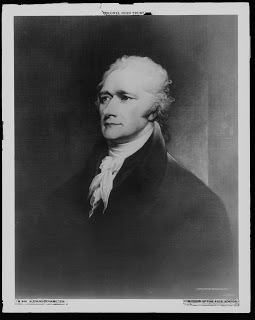 Alexander HamiltonThe Federalist party had splintered between those who supported Adams and those who followed Alexander Hamilton. Hamilton urged his supporters to abandon Adams after the two men quarreled. Meanwhile, Hamilton and Jefferson had been bitter enemies for years. Their clashing views for the future of the United States left no room for compromise.
Alexander HamiltonThe Federalist party had splintered between those who supported Adams and those who followed Alexander Hamilton. Hamilton urged his supporters to abandon Adams after the two men quarreled. Meanwhile, Hamilton and Jefferson had been bitter enemies for years. Their clashing views for the future of the United States left no room for compromise.
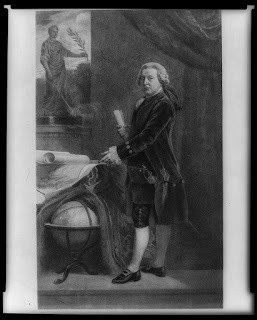 President John Adams
President John AdamsRepublicans claimed a Federalist win equaled monarchy and corruption. They spread scandal about Hamilton's affair with a married woman. Federalists in turn attacked Jefferson's luxurious lifestyle, his expensive tastes, and warned against his French connection. Did Americans want guillotines lopping off heads like in France? Jefferson's election, claimed Federalists, meant the end to churches and the burning of Bibles.
On December 3, 1800, electors met in each state and voted for the next president. Jefferson and Burr finished in a tie, 73 votes each. Adams finished third with 65 votes, a deep humiliation for the president. Now, the House of Representatives had to decide the outcome.
House members would sleep and eat in the unfinished Capitol building until they named a winner. Jefferson's supporters expected Burr to declare he was unfit, step aside, and throw his votes to Jefferson. But Burr refused. The House began voting on February 11, 1801. Rounds of voting took place; no man gained an advantage.
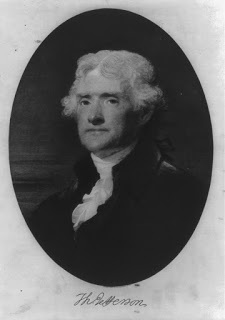 Thomas Jefferson
Thomas Jefferson
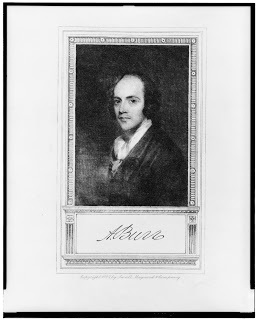 Aaron BurrSince December Hamilton had written fellow Federalists that he preferred Jefferson to Burr. Jefferson, said Hamilton, was not so dangerous and had some slim hopes to character. "As to Burr," wrote Hamilton, "there is nothing in his favor. His private character is not defended by his most partial friends."
Aaron BurrSince December Hamilton had written fellow Federalists that he preferred Jefferson to Burr. Jefferson, said Hamilton, was not so dangerous and had some slim hopes to character. "As to Burr," wrote Hamilton, "there is nothing in his favor. His private character is not defended by his most partial friends." On February 17th House members voted for the 36th time. But this round, several Federalists threw in blank ballots, as did one Burr supporter, giving Jefferson the election. In those days, the man earning the second highest vote--Aaron Burr-- became the vice president.
Jefferson saw his election as a new and bloodless American Revolution. The Federalist party never regained its former power after the election. In July, 1804 Burr killed Alexander Hamilton in a duel. Jefferson and Burr remained enemies. In 1807 President Jefferson had Burr arrested for treason, but there was not enough evidence to condemn him.
Activity: Presidential election materials, like buttons, are rare from the early 1800s. But you can make your own using Kerrie Hollihan's activity from her book, THEODORE ROOSEVELT FOR KIDS.
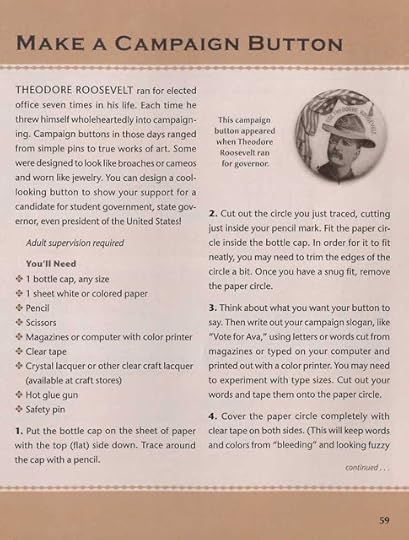
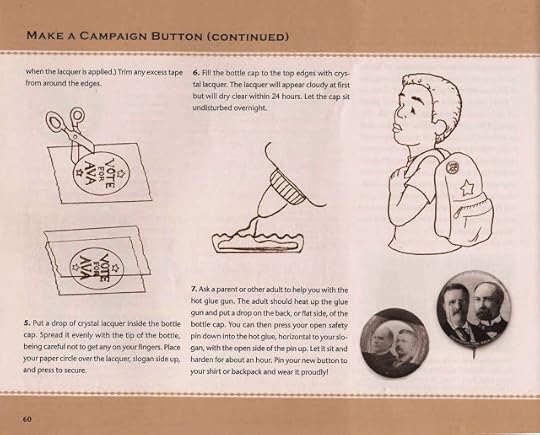
Published on September 01, 2016 08:04
August 4, 2016
Sometimes the Political is Personal
When Hillary Clinton won the Democrat nomination for US president last week, many thought that she was the first woman so honored.
Not so. Several women, Victoria Woodhull and Shirley Chisholm among them, had their names placed in nomination across the years.
The name that rings in my mind is Margaret Chase Smith, Republican senator of Maine, who was nominated at the Republican Convention at San Francisco’s Cow Palace in 1964. US Senator Barry Goldwater of Arizona, a right wing Republican, won the nomination.
Smith is remembered for taking on Sen. Joseph McCarthy in his crusade to ferret out Communists from the US during the 1950s: I don’t want to see the Republican Party ride to a political victory on the Four Horsemen of Calumny—Fear, Ignorance, Bigotry, and Smear.
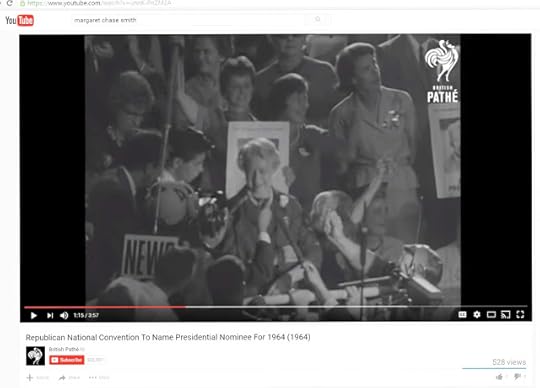
In my zeal to find a clip of Senator Smith on YouTube, I went hunting. I came on a British film reel and as I watched, there was Smith. I thought, what if I happen to see Mom there?
AND THERE WAS MY MOTHER! Behind Smith, holding a placard, arm raised. ....https://www.youtube.com/watch?v=unnK-PnZM2A%/ Years on, I wrote a book about women’s suffrage. Mom would have liked it.
From Rightfully Ours: How Women Won the Vote, comes this learning activity: Dress Up For Women’s Suffrage! Or like an Olympian. Men wear togas, too.
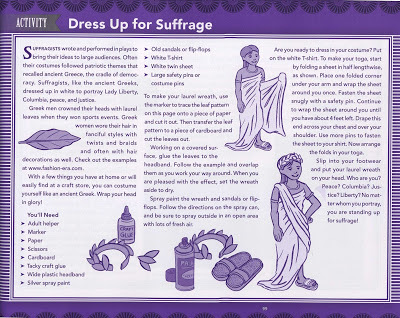
Not so. Several women, Victoria Woodhull and Shirley Chisholm among them, had their names placed in nomination across the years.
The name that rings in my mind is Margaret Chase Smith, Republican senator of Maine, who was nominated at the Republican Convention at San Francisco’s Cow Palace in 1964. US Senator Barry Goldwater of Arizona, a right wing Republican, won the nomination.
Smith is remembered for taking on Sen. Joseph McCarthy in his crusade to ferret out Communists from the US during the 1950s: I don’t want to see the Republican Party ride to a political victory on the Four Horsemen of Calumny—Fear, Ignorance, Bigotry, and Smear.

In my zeal to find a clip of Senator Smith on YouTube, I went hunting. I came on a British film reel and as I watched, there was Smith. I thought, what if I happen to see Mom there?
AND THERE WAS MY MOTHER! Behind Smith, holding a placard, arm raised. ....https://www.youtube.com/watch?v=unnK-PnZM2A%/ Years on, I wrote a book about women’s suffrage. Mom would have liked it.
From Rightfully Ours: How Women Won the Vote, comes this learning activity: Dress Up For Women’s Suffrage! Or like an Olympian. Men wear togas, too.

Published on August 04, 2016 14:39
July 1, 2016
Five Years of Hands-On-Books and Happy July 4th!
By Brandon Marie Miller
[Activity: Make A General's Epaulets]
It is hard to believe 5 years have passed since Mary Kay Carson, Kerrie Hollihan and I began Hands-On-Books! We hope you've enjoyed our bits of history, science and activities. We've had some wonderful guest bloggers along the way, too. Thanks to everyone who has checked us out!
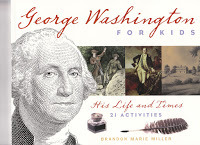 Since I've written books about several Founding Fathers, I've had the July blog a few times in honor of Independence Day. So here we go again.
Since I've written books about several Founding Fathers, I've had the July blog a few times in honor of Independence Day. So here we go again.
1776: Washington has abandoned Boston and in mid-April marches his troops to New York, a town of about 20,000 people, but mostly an area of farmland and forest. He has too few men to occupy Brooklyn Heights, Harlem Heights, Long Island, Manhattan Island and Staten Island, and protect the Hudson and East Rivers. The Americans wait for sight of the British fleet.
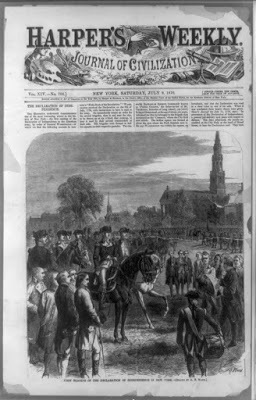 Soldiers in New York hear the Declaration of
Soldiers in New York hear the Declaration of
Independence read in this 1870 print from
Harper's Weekly. Library of CongressOn July 9, a few days after the first British forces landed on Staten Island, Washington gathers his "motely crew," as one British officer calls the American troops. The soldiers listen as an incredible document is read. Only days before in Philadelphia, Congress has approved a Declaration of Independence, severing ties between Great Britain and the free and independent states of America. This war, these men, will now fight-- not just to insure their rights as British citizens-- but for the birth of a new nation.
But Washington knows each man views his own state or region as his country. He needs a united single vision of what America can be. "The Honor and Succces of the army, and the safety of our bleeding Country, depends upon harmony and good agreement with each other," he urges his men. "Let all distinctions of Nations, Countries, and Provinces therefore be lost."
By August, 32,000 British soldiers camp on Staten Island and the masts of their vast fleet appear like a forest on the water. Washington has 19,000 men, but many of the militia soldiers will slip away as their enlistments end. The Continental Army suffers a series of failures in New York. At one point, as American soldiers dump their packs and guns and run, Washington gallops towards the British lines: "Are these the men with whom I am to defend America?" he cries. "Good God! Have I got such troops as these?" Aides rush forward, grab the reins of Washington's horse, and pull their general to safety.
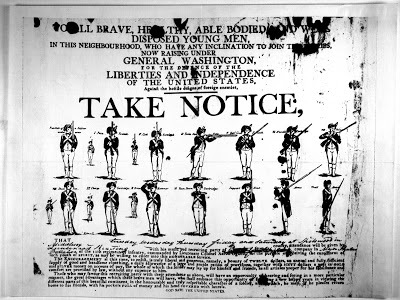 Washington always needed more soldiers. A recruiting poster.
Washington always needed more soldiers. A recruiting poster.
Library of Congress.
Well, we know things turn out just fine. But in those dark summer days of 1776, nothing was sure and failure seemed very likely.
Activity: Make A General's Epaulets

[Activity: Make A General's Epaulets]
It is hard to believe 5 years have passed since Mary Kay Carson, Kerrie Hollihan and I began Hands-On-Books! We hope you've enjoyed our bits of history, science and activities. We've had some wonderful guest bloggers along the way, too. Thanks to everyone who has checked us out!
 Since I've written books about several Founding Fathers, I've had the July blog a few times in honor of Independence Day. So here we go again.
Since I've written books about several Founding Fathers, I've had the July blog a few times in honor of Independence Day. So here we go again.1776: Washington has abandoned Boston and in mid-April marches his troops to New York, a town of about 20,000 people, but mostly an area of farmland and forest. He has too few men to occupy Brooklyn Heights, Harlem Heights, Long Island, Manhattan Island and Staten Island, and protect the Hudson and East Rivers. The Americans wait for sight of the British fleet.
 Soldiers in New York hear the Declaration of
Soldiers in New York hear the Declaration of Independence read in this 1870 print from
Harper's Weekly. Library of CongressOn July 9, a few days after the first British forces landed on Staten Island, Washington gathers his "motely crew," as one British officer calls the American troops. The soldiers listen as an incredible document is read. Only days before in Philadelphia, Congress has approved a Declaration of Independence, severing ties between Great Britain and the free and independent states of America. This war, these men, will now fight-- not just to insure their rights as British citizens-- but for the birth of a new nation.
But Washington knows each man views his own state or region as his country. He needs a united single vision of what America can be. "The Honor and Succces of the army, and the safety of our bleeding Country, depends upon harmony and good agreement with each other," he urges his men. "Let all distinctions of Nations, Countries, and Provinces therefore be lost."
By August, 32,000 British soldiers camp on Staten Island and the masts of their vast fleet appear like a forest on the water. Washington has 19,000 men, but many of the militia soldiers will slip away as their enlistments end. The Continental Army suffers a series of failures in New York. At one point, as American soldiers dump their packs and guns and run, Washington gallops towards the British lines: "Are these the men with whom I am to defend America?" he cries. "Good God! Have I got such troops as these?" Aides rush forward, grab the reins of Washington's horse, and pull their general to safety.
 Washington always needed more soldiers. A recruiting poster.
Washington always needed more soldiers. A recruiting poster.Library of Congress.
Well, we know things turn out just fine. But in those dark summer days of 1776, nothing was sure and failure seemed very likely.
Activity: Make A General's Epaulets

Published on July 01, 2016 06:09
June 1, 2016
Get Ready to ROAD TRIP!
by Mary Kay Carson
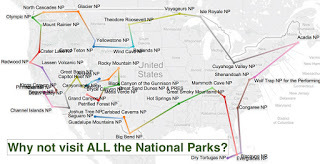 School's almost out and summer is nearly here! What better time for a road trip? No matter if you're headed off on a grand tour of America's national parks to celebrate the NPS Centennial, or simply visiting relatives in a nearby town, allow students and children the opportunity to help with trip planning.
School's almost out and summer is nearly here! What better time for a road trip? No matter if you're headed off on a grand tour of America's national parks to celebrate the NPS Centennial, or simply visiting relatives in a nearby town, allow students and children the opportunity to help with trip planning.
MAP IT
A fun way to get kids involved and excited about traveling is to map your route and work on an itinerary together. The map above was generated online, but a paper map works great, too. If you'd like to go high-tech, Google maps lets you plan routes and save places and there are many other apps, too. Just search for "route planner."
PLAN IT
Once you've roughed-out a route, start adding sites to see and places to stay. Perhaps let one student or child choose a single day to completely plan his or herself.

Not going to make it anywhere this summer? You can always take a mini-trip inside the pages of a book! Try Park Scientists : Gila Monsters, Geysers, and Grizzly Bears in America's Own Backyard, a book for young readers in Houghton Mifflin Harcourt’s Scientists in the Field series.
Happy Trails!
 School's almost out and summer is nearly here! What better time for a road trip? No matter if you're headed off on a grand tour of America's national parks to celebrate the NPS Centennial, or simply visiting relatives in a nearby town, allow students and children the opportunity to help with trip planning.
School's almost out and summer is nearly here! What better time for a road trip? No matter if you're headed off on a grand tour of America's national parks to celebrate the NPS Centennial, or simply visiting relatives in a nearby town, allow students and children the opportunity to help with trip planning.MAP IT
A fun way to get kids involved and excited about traveling is to map your route and work on an itinerary together. The map above was generated online, but a paper map works great, too. If you'd like to go high-tech, Google maps lets you plan routes and save places and there are many other apps, too. Just search for "route planner."
PLAN IT
Once you've roughed-out a route, start adding sites to see and places to stay. Perhaps let one student or child choose a single day to completely plan his or herself.

Not going to make it anywhere this summer? You can always take a mini-trip inside the pages of a book! Try Park Scientists : Gila Monsters, Geysers, and Grizzly Bears in America's Own Backyard, a book for young readers in Houghton Mifflin Harcourt’s Scientists in the Field series.
Happy Trails!
Published on June 01, 2016 04:00
May 1, 2016
Celebrate the National Park Service Centennial!
This summer the National Park Service (NPS) will turn 100 years old. Green-uniformed rangers in their iconic calvary hats started serving America in 1916. The National Park Service manages and protects some of the continent's most treasured places—from Acadia to Zion. Our national parks have been called “America’s best idea” and welcome more than 270 million visitors each year.

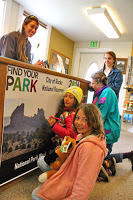 credit: Wallace Kecksynchronous fireflies and another investigating salamanders in Great Smoky Mountain. Geyser experts gave a tour in Yellowstone and ecologists let us help track Gila monsters and measure cacti in Saguaro. The result was
Park Scientists
: Gila Monsters, Geysers, and Grizzly Bears in America's Own Backyard, a book for young readers in Houghton Mifflin Harcourt’s Scientists in the Field series.
credit: Wallace Kecksynchronous fireflies and another investigating salamanders in Great Smoky Mountain. Geyser experts gave a tour in Yellowstone and ecologists let us help track Gila monsters and measure cacti in Saguaro. The result was
Park Scientists
: Gila Monsters, Geysers, and Grizzly Bears in America's Own Backyard, a book for young readers in Houghton Mifflin Harcourt’s Scientists in the Field series.
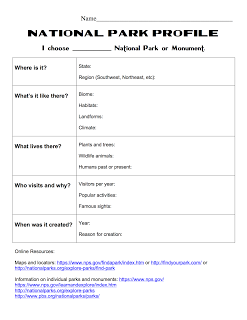 As part of the celebration, NPS is encouraging everyone to discover nearby national parks. It's called Find My Park and displays parks by state or zip code. Try it out! Not able to travel right now? Engage young people in the centennial with a virtual road trip to a national park or national monument. How? First, invite kids to choose a national park or national monument to profile using a road map or the online NPS map. Then have them research the park or monument to fill out this graphic organizer.
As part of the celebration, NPS is encouraging everyone to discover nearby national parks. It's called Find My Park and displays parks by state or zip code. Try it out! Not able to travel right now? Engage young people in the centennial with a virtual road trip to a national park or national monument. How? First, invite kids to choose a national park or national monument to profile using a road map or the online NPS map. Then have them research the park or monument to fill out this graphic organizer.
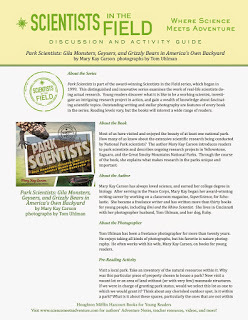 Click to download the Teaching Guide!
Click to download the Teaching Guide!
Encourage students to turn their information into a travel poster, brochure, or audio/video advertisement. The resources on the graphic organizer include links to fantastic images they can download.
Want more ideas? Check out the standards-aligned activities in the free reading and teaching guide for Park Scientists : Gila Monsters, Geysers, and Grizzly Bears in America's Own Backyard!
Happy 100th, National Park Service!!

 credit: Wallace Kecksynchronous fireflies and another investigating salamanders in Great Smoky Mountain. Geyser experts gave a tour in Yellowstone and ecologists let us help track Gila monsters and measure cacti in Saguaro. The result was
Park Scientists
: Gila Monsters, Geysers, and Grizzly Bears in America's Own Backyard, a book for young readers in Houghton Mifflin Harcourt’s Scientists in the Field series.
credit: Wallace Kecksynchronous fireflies and another investigating salamanders in Great Smoky Mountain. Geyser experts gave a tour in Yellowstone and ecologists let us help track Gila monsters and measure cacti in Saguaro. The result was
Park Scientists
: Gila Monsters, Geysers, and Grizzly Bears in America's Own Backyard, a book for young readers in Houghton Mifflin Harcourt’s Scientists in the Field series.  As part of the celebration, NPS is encouraging everyone to discover nearby national parks. It's called Find My Park and displays parks by state or zip code. Try it out! Not able to travel right now? Engage young people in the centennial with a virtual road trip to a national park or national monument. How? First, invite kids to choose a national park or national monument to profile using a road map or the online NPS map. Then have them research the park or monument to fill out this graphic organizer.
As part of the celebration, NPS is encouraging everyone to discover nearby national parks. It's called Find My Park and displays parks by state or zip code. Try it out! Not able to travel right now? Engage young people in the centennial with a virtual road trip to a national park or national monument. How? First, invite kids to choose a national park or national monument to profile using a road map or the online NPS map. Then have them research the park or monument to fill out this graphic organizer. Click to download the Teaching Guide!
Click to download the Teaching Guide!Encourage students to turn their information into a travel poster, brochure, or audio/video advertisement. The resources on the graphic organizer include links to fantastic images they can download.
Want more ideas? Check out the standards-aligned activities in the free reading and teaching guide for Park Scientists : Gila Monsters, Geysers, and Grizzly Bears in America's Own Backyard!
Happy 100th, National Park Service!!
Published on May 01, 2016 13:07
April 13, 2016
Happy 100th Birthday, National Park Service!
[image error]
This summer the National Park Service (NPS) turns one hundred years old. Celebrate by tagging along with the scientists profiled in Park Scientists: Gila Monsters, Geysers, and Grizzly Bears in America's Own Backyard, a book for young readers from Houghton Mifflin Harcourt���s prestigious Scientists in the Field series.
Readers will discover grizzly bears and geysers in Yellowstone, the iconic saguaro cacti and venomous Gila monsters in Arizona, and salamander and synchronous fireflies in the Great Smoky Mountains. Readers of all ages will be inspired to visit parks and perhaps participate in citizen science projects.
Get a sneak peak by watching the Park Scientists book trailer on YouTube!
Readers will discover grizzly bears and geysers in Yellowstone, the iconic saguaro cacti and venomous Gila monsters in Arizona, and salamander and synchronous fireflies in the Great Smoky Mountains. Readers of all ages will be inspired to visit parks and perhaps participate in citizen science projects.
Get a sneak peak by watching the Park Scientists book trailer on YouTube!
Published on April 13, 2016 07:42
April 4, 2016
Four years ago, Rightfully Ours was just ready for public...
Four years ago, Rightfully Ours was just ready for publication. This month I'm taking a look back at my first post about this middle grade history of women's suffrage in the United States.
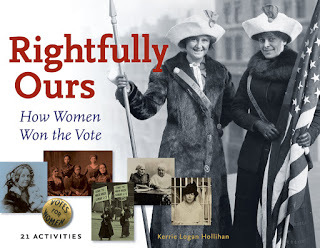 When Mary Kay, Brandon, and I launched this blog last summer, we took the advice of digital media guru Jane Friedman, who writes Electric Speed (http://janefriedman.com) and tried to make it useful. Hence a book blog that offers you, our readers, activities to print and share. Activities help our readers grasp something about the people and times we write about.
When Mary Kay, Brandon, and I launched this blog last summer, we took the advice of digital media guru Jane Friedman, who writes Electric Speed (http://janefriedman.com) and tried to make it useful. Hence a book blog that offers you, our readers, activities to print and share. Activities help our readers grasp something about the people and times we write about.
Which leads to my new book, Rightfully Ours: How Women Won the Vote with 21 Activities. Reviews are out, and it’s been gratifying to see that a year of hard work -- and planning and writing up 21 themed, hands-on activities -- has gotten positive reviews. Here’s one:
Activities, which make the suffragist years come alive, are educational and fun and related to chapter materials. Included are detailed instructions for making soap and an oil lamp, making and wearing a corset, china painting, and designing suffragist postcards and signs.
And another:
The only downside is the activities, which range from slightly silly (dress up like an ancient Greek for suffrage!) to simply wrong (cake mix does not taste as good as a cake made from scratch).
The second review left me scratching my head. Yup, I rely on cake mix in an activity in Rightfully Ours. It’s “Bake a Cake for Suffrage” iced with a recipe from the Woman Suffrage Cook Book (1890). After all, today’s parents have little time to ferret out some of these 19th century recipes, so I figured making icing from scratch on the stove was good enough. But it was the reviewer’s take on the dress-up activity that made me wonder whether s/he had read the whole book.
Suffragists did indeed dress up like Greek goddesses when they staged a “tableau” on the Treasury Department steps. And I assure you that the little girl who served as my student helper thought it was pretty cool -- she was all excited about making the laurel wreath.
 From time to time all of us have been chided for our activities -- that they’re too easy, too esoteric, too “silly” (that from Kirkus), require adult supervision (often an editorial must) -- but be assured that we take them seriously. Teachers tell us there are lots of middle grade kids, especially boys, who have no clue how to follow simple directions, enlarge patterns, score a piece of cardboard, or even cut a circle with a pair of scissors.
From time to time all of us have been chided for our activities -- that they’re too easy, too esoteric, too “silly” (that from Kirkus), require adult supervision (often an editorial must) -- but be assured that we take them seriously. Teachers tell us there are lots of middle grade kids, especially boys, who have no clue how to follow simple directions, enlarge patterns, score a piece of cardboard, or even cut a circle with a pair of scissors.
Besides, when you look back on your days in school, which do you remember most: all those hours of desk work, or the special projects you made at home or built in school?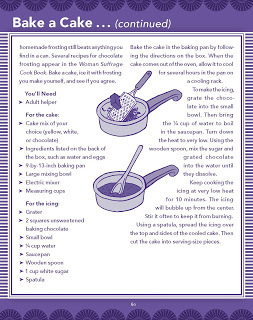 Bake a cake, ice it with homemade frosting, and dress up for suffrage!
Bake a cake, ice it with homemade frosting, and dress up for suffrage!
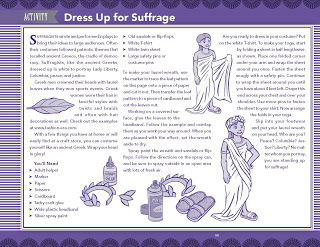
 When Mary Kay, Brandon, and I launched this blog last summer, we took the advice of digital media guru Jane Friedman, who writes Electric Speed (http://janefriedman.com) and tried to make it useful. Hence a book blog that offers you, our readers, activities to print and share. Activities help our readers grasp something about the people and times we write about.
When Mary Kay, Brandon, and I launched this blog last summer, we took the advice of digital media guru Jane Friedman, who writes Electric Speed (http://janefriedman.com) and tried to make it useful. Hence a book blog that offers you, our readers, activities to print and share. Activities help our readers grasp something about the people and times we write about.Which leads to my new book, Rightfully Ours: How Women Won the Vote with 21 Activities. Reviews are out, and it’s been gratifying to see that a year of hard work -- and planning and writing up 21 themed, hands-on activities -- has gotten positive reviews. Here’s one:
Activities, which make the suffragist years come alive, are educational and fun and related to chapter materials. Included are detailed instructions for making soap and an oil lamp, making and wearing a corset, china painting, and designing suffragist postcards and signs.
And another:
The only downside is the activities, which range from slightly silly (dress up like an ancient Greek for suffrage!) to simply wrong (cake mix does not taste as good as a cake made from scratch).
The second review left me scratching my head. Yup, I rely on cake mix in an activity in Rightfully Ours. It’s “Bake a Cake for Suffrage” iced with a recipe from the Woman Suffrage Cook Book (1890). After all, today’s parents have little time to ferret out some of these 19th century recipes, so I figured making icing from scratch on the stove was good enough. But it was the reviewer’s take on the dress-up activity that made me wonder whether s/he had read the whole book.

Suffragists did indeed dress up like Greek goddesses when they staged a “tableau” on the Treasury Department steps. And I assure you that the little girl who served as my student helper thought it was pretty cool -- she was all excited about making the laurel wreath.
 From time to time all of us have been chided for our activities -- that they’re too easy, too esoteric, too “silly” (that from Kirkus), require adult supervision (often an editorial must) -- but be assured that we take them seriously. Teachers tell us there are lots of middle grade kids, especially boys, who have no clue how to follow simple directions, enlarge patterns, score a piece of cardboard, or even cut a circle with a pair of scissors.
From time to time all of us have been chided for our activities -- that they’re too easy, too esoteric, too “silly” (that from Kirkus), require adult supervision (often an editorial must) -- but be assured that we take them seriously. Teachers tell us there are lots of middle grade kids, especially boys, who have no clue how to follow simple directions, enlarge patterns, score a piece of cardboard, or even cut a circle with a pair of scissors. Besides, when you look back on your days in school, which do you remember most: all those hours of desk work, or the special projects you made at home or built in school?
 Bake a cake, ice it with homemade frosting, and dress up for suffrage!
Bake a cake, ice it with homemade frosting, and dress up for suffrage!
Published on April 04, 2016 14:47
September 23, 2015
Starred Reviews for INSIDE BIOSPHERE 2!
[image error]
School Library Journal and Booklist both give my new book in the Scientists in the Field series, Inside Biosphere 2: Earth Science Under Glass, starred reviews in their fall issues! SLJ says, ���This enlightening title adeptly connects Biosphere 2���s past with its present and future. Stunning photographs, clear and colorful graphics, and illuminating insets enhance the appeal...Highly recommended for all middle school science collections." Booklist���s review says, "From examining how forests handle climate change to the impact of the ocean becoming more acidic, to developing a deeper understanding of the water cycle for soil erosion, and to predicting climate conditions, the scope of the research is vast...Truly eye-opening." Find out more here.
Published on September 23, 2015 09:24



